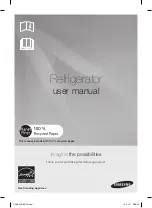
8
•
WE RECOMMEND THAT FROZEN FISH AND SAUSAGE SHOULD BE STORED IN THE
FREEZER COMPARTMENT NOT LONGER THAN 6 MONTHS; CHEESE, POULTRY, PORK,
LAMB – NOT MORE THAN 8 MONTHS; BEEF, FRUIT AND VEGETABLES – NOT
LONGER THAN 12 MONTHS.
DEFROSTING
THE REFRIGERATOR COMPARTMENT defrosts automatically. Drops of ice that form on
the back wall of the refrigerator compartment thaw during the time the compressor is
not working and the thaw water runs down the thaw water runoff channel to the tray
on top of the compressor (Fig. 1), where it evaporates.
FREEZER COMPARTMENT should be thawed not less than twice a year or when a layer
of ice thicker than 5 mm forms in it. Do the actions below in the order they are listed:
WARNING! Turn the appliance off and pull the plug out of the
electrical socket.
•
Remove foodstuffs from freezer compartment. The frozen foodstuffs will not warm
up too much while you are thawing the freezer compartment if you cover them with a
thick cloth and keep them in a cool place.
•
Leave door of appliance open. When the ice melts, clean and wipe dry the surfaces
and fixtures of the refrigerator and freezer compartments.
•
Close the appliance door. Plug in and turn on the appliance.
CLEANING AND CARE
REGULARLY CLEAN THE APPLIANCE.
Remember that before defrosting the appliance and cleaning
the back part of the appliance body you must disconnect the
appliance from the electrical energy supply socket by pulling the
plug out of the electricity outlet.
•
Protect the appliance inner surfaces and plastic parts from fats, acids and sauces. In
case of accidental spills – immediately clean with warm soapy water or dishwashing
detergent. Wipe dry.
•
Clean the appliance inner surfaces with warm soapy water. Dishwashing detergent
may also be used.
•
Wipe dry inner and outer surfaces.
•
Regularly clean the hermetic gaskets of the doors. Wipe dry.
•
REGULARLY CLEAN THE THAW WATER CHANNEL SPACE IN THE
REFRIGERATOR WITH A SPECIAL CLEANER FOR THAT PURPOSE
(see fig.).
•
At least once a year clean dust away from the back part of the
appliance body and the compressor. A soft brush, electrostatic
cloth or vacuum cleaner may be used for cleaning (see fig.).
•
DO NOT use detergents containing abrasive particles, acid, alcohol
or benzene for cleaning the appliance inner and outer surfaces.
•
DO NOT use for cleaning cloths or sponges that have coarse
surfaces intended for scrubbing.































